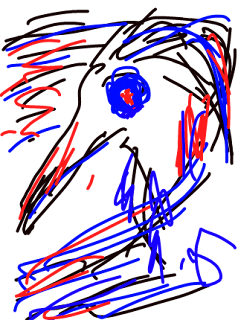Hearing Sounds
People are always telling us to get a life but don’t tell how. This koan tells how. Any fragment of experience contains a whole life, including the single celled creatures and the galaxies, including every triumph and defeat you might ever have. The moment exists before anyone has succeeded or failed or been virtuous or unhappy.

The koan this week:
Who is hearing this sound?
Anger, sorrow, cherry blossoms, the voice of a crow, a speeding Toyota, these appear in the mind. You can try to hold off what is rising in the mind and get a little space that way, but doing that is really a kind of pain and loss, and living at a distance from your life is hard work.
This koan tries it another way. Instead of turning away from the world, you can let the koan throw you into whatever is appearing. You don’t have to look for a place to stand. If you jump straight into what is arising, the koan starts to shape what is happening. The koan can operate below the level at which you usually manage things. So that is the hearing aspect of this koan. Just let hearing have you. This koan can be carried everywhere with you.
The idea is that it will take apart the building that you constructed to hold unhappiness. You don’t have to think, you just listen; you don’t go out to the sound to make out what it is and explain it, you just let the sound eat, and breathe, and go to sleep at night, you let the sound listen to you.
The next bit is the question—who hears? When the sound takes you over, it shifts what you are. There isn’t much left that is what you think you are. When there is just sound in the universe, what is it like to be me? Is there even a difference between that sound and me? And if this is true for sound, how about for the old wooden fence bright with green winter moss? You don’t either agree with the fence or disagree with it. And what about when I look into the eyes of another person? There is also nothing to have an opinion about there. And then if we come to sorrow or anger it is the same; you are not fighting it or agreeing with it. It is just the brightness of life. Any content arising in the mind is more or less equal in this way.
 |
| John Cage |
For example you might want to look at what it is like to want things to be familiar and safe. And then you wonder whether you really do want things to be predictable. I just watched John Cage on an ancient TV show “I’ve Got a Secret” (http://www.wnyc.org/music/articles/84007) in which he performs a musical piece called “Water Walk” using a pressure cooker, a bathtub, a rubber duck, a pitcher, a goose call, some radios not turned on, a seltzer bottle and so on, even a piano. The host warns him that the audience will laugh. "I consider laughter preferable to tears," he replies. There is an immense good humor in the way he lets each sound take over the piece.
There is an Australian bird, a currawong, which is an ally of the jays and crows, intelligent and peculiar. I once lived in a house in the country, where currawongs held parliaments. Every few months, without warning, they would appear in the trees in the garden by the hundreds, calling loudly and swooping from tree to tree. And when they had finished their meeting, which would last the morning, they would vanish and there would be only the usual two or three currawongs visible between the house and the horizon. While they convened, their calls were so loud that conversation would stop. Their voices took us over, they would tip themselves off branches on purpose and catch themselves, executing a fine swoop, and I can still feel that swoop in my shoulders, the wings there, catching me as I fall.
Craig Childs tells a story in his book The Animal Dialogues about hearing ravens and beginning to understand things from their point of view. He followed a raven into an narrow canyon not otherwise visible. It opened out and had high walls filled with perching ravens. The ravens had killed an owl and, deep in the canyon, had placed owl feathers under stones in an array. As he went farther in, the ravens began to call and protest. They screamed at him, they swooped and threw pebbles. He turned back. Another day he came back with a friend and the same thing happened. The men came to see things from the point of view of the ravens—that this was a raven place, and that they had no business being there.
 When you really hear, your understanding comes in a way that’s different from the usual.
When you really hear, your understanding comes in a way that’s different from the usual.Questions:
1. What do you hear?
2. What do you try not to hear? How is it for you to make room for that, too?
3. What do you hear with your tongue? your eyes? your fingertips? your nose?
4. When you don't use words, who hears?
5. Close your eyes, put your hands over your ears, who hears?
6. Has there ever been a time when you’ve switched point of view with something or someone else?
7. Are there sounds you remember from childhood?





